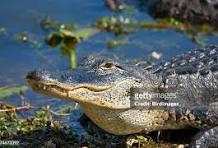Alligators are large reptiles belonging to the genus Alligator of the family Alligatoridae. There are two extant species: the American alligator (A. mississippiensis) and the Chinese alligator (A. sinensis). Additionally, several extinct species of alligator are known from fossil remains. Alligators first appeared during the late Eocene epoch about 37 million years ago.
Physical Description
Alligators are large, stocky reptiles with powerful legs and long, muscular tails. They have a broad head with a long snout lined with sharp teeth. Their eyes, ears, and nostrils are positioned on the top of their head, allowing them to breathe and see while most of their body is submerged underwater.
- American alligators are the larger of the two species, typically reaching lengths of up to 4 meters (13 feet) and weighing up to 450 kg (990 lb).
- Chinese alligators are much smaller, rarely exceeding 2.1 meters (7 ft) in length and weighing considerably less.
Habitat
Alligators are semi-aquatic reptiles that inhabit freshwater wetlands, such as swamps, marshes, and lakes. They are found in parts of North America (American alligator) and East Asia (Chinese alligator).
Diet
Alligators are carnivores and opportunistic feeders. They primarily eat fish, amphibians, reptiles, birds, and small mammals. Their powerful jaws and sharp teeth allow them to crush through bone and tough prey.
Behavior
Alligators are solitary animals for most of their lives. They come together only to mate and raise their young. They are territorial and will defend their territory from other alligators. Alligators are excellent swimmers and can move surprisingly fast in short bursts. They are also adept at digging burrows, which they use for shelter and thermoregulation.
Reproduction
Alligators are oviparous, meaning they lay eggs. Females lay a clutch of up to 50 eggs in a nest built out of vegetation. The eggs incubate for several weeks before hatching. After hatching, the young alligators are cared for by their mother for a few years.
Conservation Status
The conservation status of alligators varies depending on the species.
- The American alligator was once listed as endangered but has since made a comeback and is now listed as least concern by the IUCN.
- The Chinese alligator is critically endangered due to habitat loss and hunting. Conservation efforts are underway to protect this species.
Alligators are an important part of the ecosystems they inhabit. They help to control prey populations and keep waterways healthy. They are also a popular tourist attraction, generating revenue for local economies.


